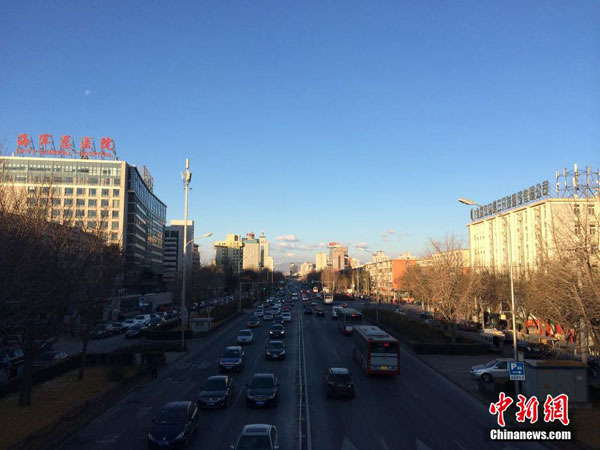


A photo taken on December 2nd, 2015, shows Beijing's street scenery a blue sky. [Photo: Chinanews.com]
Beijing's average PM2.5 density in 2015 dropped by 9.9 percent from that in 2013.
The decrease comes after the city's two-year long effort to curb pollution.
The city's Municipal Environmental Protection Bureau said the average densities of sulfur dioxide and nitrogen dioxide in 2015 also decreased by 49 percent and 11 percent respectively from two years prior.
Yu Jianhua, chief engineer with the bureau, details Beijing's efforts.
"Four gas-fired heat and power centers have been put into use in the past two years and three of the four coal-fired power plants were shut down. Nearly no coal-fired boilers are used in the six urban districts. We should say that the city's total coal use in the past two years has been reduced by nearly half."
Beijing's coal use in 2015 dropped to 12 million tonnes, but reducing coal use and vehicle emissions have remained important tasks for the capital city in 2016.
Meanwhile, the Municipal Commission of Urban Planning in Beijing is planning to build a web of ventilation corridors to facilitate air flow and blow away smog and pollutants.
Deputy director of the commission, Wang Fei, said the five primary ventilation corridors are designed to be more than 500 meters in width. Some secondary corridors will be over 80 meters wide.
"Five first-level and a dozen of second-level ventilation tunnels will be built. There might even be third-level ones in the future. Based on the different conditions of the tunnels, we will conduct further studies with meteorological departments and related experts. Each tunnel will have a model. The aim is to ease the urban heat island effect and decrease air pollution."
Beijing began monitoring PM 2.5 levels in 2013 amid rising public concerns over pollution in the city.
The city recorded 186 days of adequate air quality in 2015.
In total, that is 14 days more than the year previous.
 2016 Miss Chinatown USA pageant held in San Francisco
2016 Miss Chinatown USA pageant held in San Francisco Ancient pagodas across China
Ancient pagodas across China Beijing Film Academy starts 2016 entrance exam
Beijing Film Academy starts 2016 entrance exam Wedding dress show up in the air
Wedding dress show up in the air Have you ever taken these beautiful subways in China?
Have you ever taken these beautiful subways in China? Russian photographer brings fairytales to life
Russian photographer brings fairytales to life Chinese beauties, foreign models meet in Chengdu
Chinese beauties, foreign models meet in Chengdu Awesome! Aerial pictures taken on J-11 fighter
Awesome! Aerial pictures taken on J-11 fighter A foreign girl explains what China should be proud of
A foreign girl explains what China should be proud of Top 20 hottest women in the world in 2014
Top 20 hottest women in the world in 2014 Top 10 hardest languages to learn
Top 10 hardest languages to learn 10 Chinese female stars with most beautiful faces
10 Chinese female stars with most beautiful faces China’s Top 10 Unique Bridges, Highways and Roads
China’s Top 10 Unique Bridges, Highways and Roads Shooting threat mixes online, offline violence
Shooting threat mixes online, offline violence Chinese peacekeepers face violence, food shortages on UN mission
Chinese peacekeepers face violence, food shortages on UN mission Regulations concerning menstrual pain leave a step in the right direction
Regulations concerning menstrual pain leave a step in the right directionDay|Week